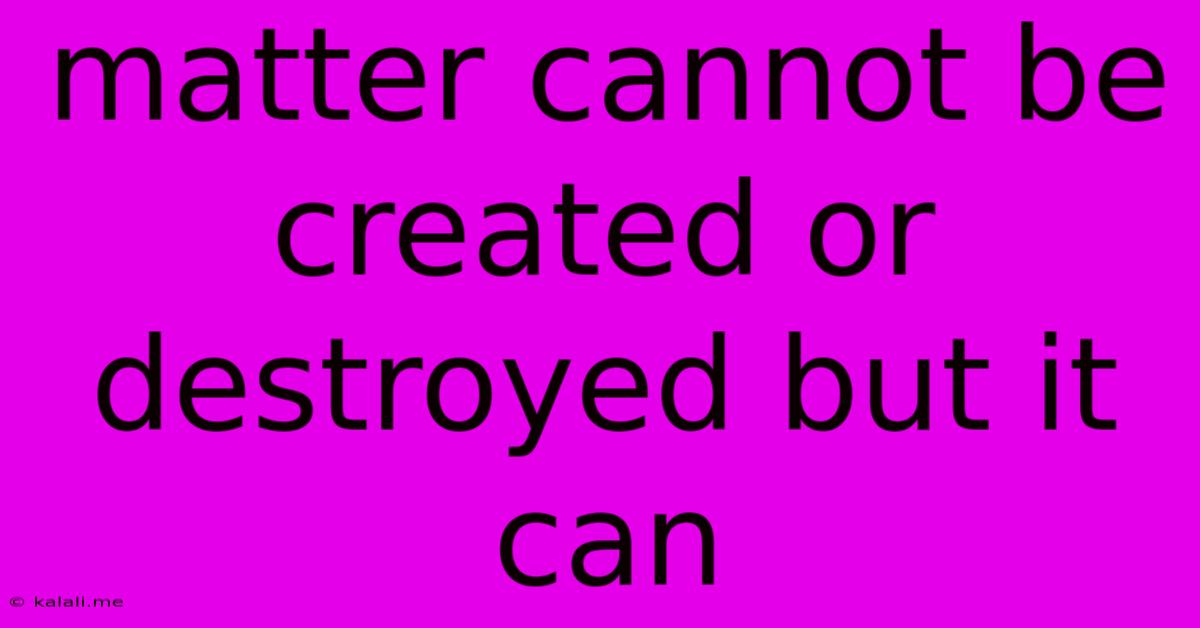Matter Cannot Be Created Or Destroyed But It Can
Kalali
May 23, 2025 · 3 min read

Table of Contents
Matter Cannot Be Created or Destroyed, But It Can… Transform!
Meta Description: Explore the fascinating law of conservation of mass, understanding that while matter can't be created or destroyed, it undergoes incredible transformations through physical and chemical changes. Learn about the implications of this fundamental principle in various scientific fields.
The statement "matter cannot be created or destroyed" is a cornerstone of classical physics, specifically the law of conservation of mass. This principle asserts that the total mass in a closed system remains constant, regardless of the processes occurring within it. However, a more accurate and complete understanding reveals that while matter itself isn't created or destroyed, it can undergo remarkable transformations. This nuance is crucial to fully grasp the implications of this fundamental scientific law.
Understanding the Law of Conservation of Mass
The law of conservation of mass, attributed to Antoine Lavoisier, dictates that in a chemical reaction, the total mass of the reactants (the substances undergoing change) equals the total mass of the products (the resulting substances). This seemingly simple statement underpins countless chemical processes and calculations. For example, when wood burns, the mass of the ash, smoke, and gases produced exactly equals the original mass of the wood and oxygen consumed in the combustion process.
However, Einstein's theory of relativity introduced a crucial amendment. The famous equation, E=mc², demonstrates the equivalence of energy and mass. This means that mass can be converted into energy, and vice versa. This doesn't invalidate the conservation principle; instead, it expands it. The total amount of mass-energy within a closed system remains constant.
Transformations of Matter: Physical and Chemical Changes
The apparent "destruction" or "creation" of matter is often a result of changes in its form and state. Let's explore these transformations:
1. Physical Changes: These changes alter the physical properties of matter, such as shape, size, or state (solid, liquid, gas), without changing its chemical composition. Examples include:
- Melting ice: Ice (solid water) transforms into liquid water, changing its state but not its chemical formula (H₂O).
- Boiling water: Liquid water becomes water vapor (gas), again a change of state, not composition.
- Crushing a can: The can changes shape, but its chemical makeup remains the same.
2. Chemical Changes: These changes involve the rearrangement of atoms and molecules, resulting in the formation of new substances with different chemical properties. Examples include:
- Burning wood: Wood (a complex mixture of organic compounds) reacts with oxygen to produce carbon dioxide, water vapor, and ash, completely altering its chemical composition.
- Rusting iron: Iron reacts with oxygen and water to form iron oxide (rust), a new compound with different properties.
- Photosynthesis: Plants convert carbon dioxide and water into glucose (sugar) and oxygen, a fundamental chemical transformation vital for life on Earth.
In chemical reactions, while the atoms themselves are neither created nor destroyed, they are rearranged to form new molecules, leading to a change in the overall chemical composition. The total mass, however, remains consistent, accounting for the mass of all reactants and products.
Implications Across Scientific Disciplines
The law of conservation of mass is paramount across various scientific fields:
- Chemistry: Essential for stoichiometry (calculations involving the quantities of reactants and products in chemical reactions).
- Nuclear Physics: Although mass can be converted to energy (and vice versa), the total mass-energy remains constant.
- Environmental Science: Understanding the transformation of matter is crucial for studying pollution, waste management, and the cycling of nutrients in ecosystems.
In conclusion, while the classical statement "matter cannot be created or destroyed" needs refinement in light of Einstein's theory of relativity, the fundamental principle of mass-energy conservation remains a cornerstone of modern science. Matter undergoes continuous transformations through physical and chemical processes, but the total mass-energy within a closed system is always conserved, highlighting the remarkable dynamism and interconnectedness of our universe.
Latest Posts
Latest Posts
-
20 Amp Switch On A 15 Amp Circuit
May 25, 2025
-
Does A Magnet Count As Potential Energy
May 25, 2025
-
Bash Fork Retry Resource Temporarily Unavailable
May 25, 2025
-
Is The Song You Raise Me Up A Christian Song
May 25, 2025
-
Can You Fix A Seized Engine
May 25, 2025
Related Post
Thank you for visiting our website which covers about Matter Cannot Be Created Or Destroyed But It Can . We hope the information provided has been useful to you. Feel free to contact us if you have any questions or need further assistance. See you next time and don't miss to bookmark.